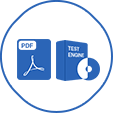Last Update 20 hours ago Total Questions : 80
The SAP Certified Associate - Data Engineer - SAP BW/4HANA content is now fully updated, with all current exam questions added 20 hours ago. Deciding to include C_BW4H_2505 practice exam questions in your study plan goes far beyond basic test preparation.
You'll find that our C_BW4H_2505 exam questions frequently feature detailed scenarios and practical problem-solving exercises that directly mirror industry challenges. Engaging with these C_BW4H_2505 sample sets allows you to effectively manage your time and pace yourself, giving you the ability to finish any SAP Certified Associate - Data Engineer - SAP BW/4HANA practice test comfortably within the allotted time.
What are the reasons for implementing CompositeProviders?Note: There are 2 correctanswers to this question.
In an SAP HANA smart data integration flowgraph, which transformation options are available?Note: There are 3 correctanswers to this question.
You want to access data from a table residing in an external database using an SAP HANA SDA remote source.Which other SAP HANA element is required to access its data?
In which ODP context is the operational delta queue (ODQ) managed by the target system?
With SAP BW/4HANA, the new HANA-optimized business content is designed according to the LSA++ framework.Which technical namespace is assigned to identify the new SAP ERP-related business content?
What are some of the prerequisites for using SAP S/4HANA ABAP CDS views for extraction into SAP BW/4HANA in an ODP context? Note: There are 2 correctanswers to this question.
You notice that an SAP ERP ODP_SAP DataSource is delivering incorrect values into the first persistent data layer in SAP BW/4HANWhich options do you have to analyze a potential extractor issue? Note: There are 2 correctanswers to this question.

